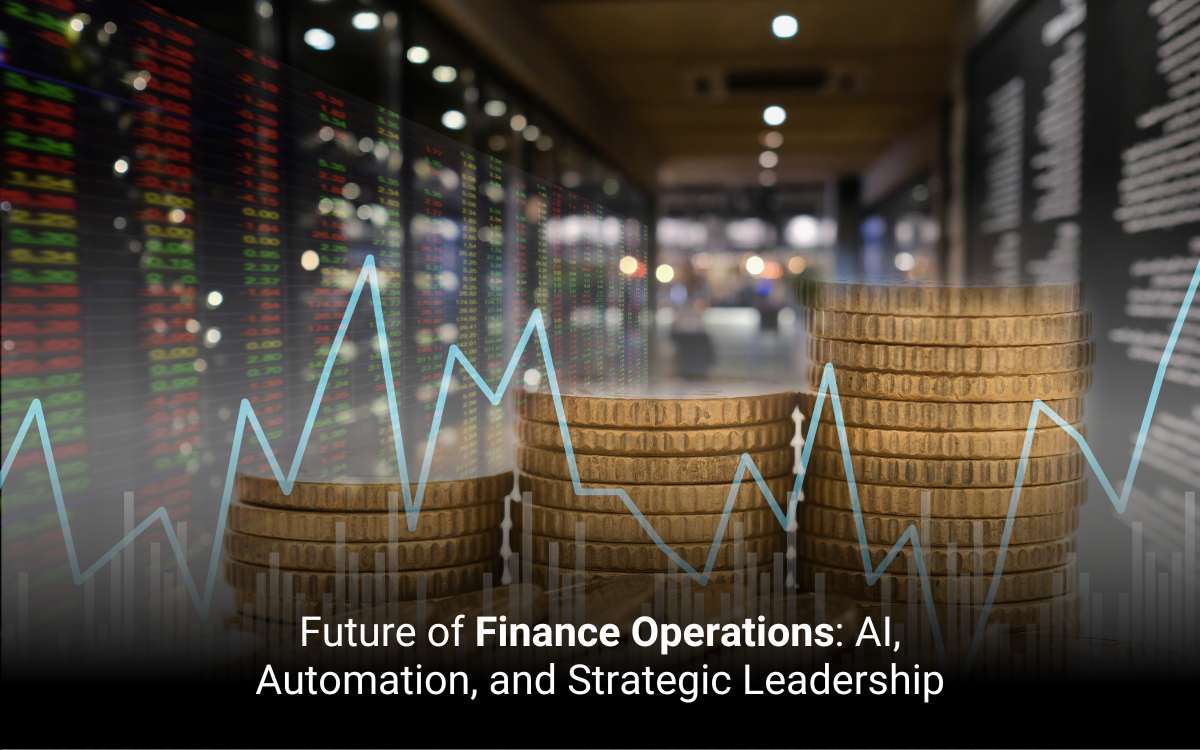Future of Finance Operations: AI, Automation, and Strategic Leadership

The CFO reviews financial reports generated throughout the quarter. Predictive models have flagged cash flow fluctuations, robotic process automation (RPA) has gathered transactions with zero errors, and an AI dashboard analyzes decisions for the week ahead. It is the new reality of finance operations, where AI, Automation, and strategic leadership converge to redefine how businesses grow.
AI is empowering through predictive analytics, ML algorithms, and NLP, transforming raw financial data into insights. Meanwhile, Automation is eliminating manual tasks through intelligent bots that operate around the clock. But technology alone isn’t enough. The transformation also depends on strategic leadership that bridges the gap between digital tools and business outcomes.
This article will explore how AI, Automation, and strategic leadership are shaping Finance.
How AI Has Changed the Course of Finance
Below are keyways AI is transforming the course of Finance.
1. Predictive Forecasting
AI-driven forecasting models leverage real-time analytics to anticipate outcomes. For instance, businesses use AI predictive analytics to simulate different scenarios and guide investment decisions for volatile markets.
2. Intelligent Automation for Efficiency
By combining AI, Automation, and Robotic Process Automation (RPA), it can process invoices and manage expense reports. For example, a firm implemented RPA in its finance operations to automate transactions, resulting in faster closing cycles.
3. Risk Management and Fraud Detection
AI is transforming risk management by identifying anomalies and potential fraud patterns. ML algorithms analyze transactions to flag inconsistencies. A global payment firm deploys AI systems that detect fraudulent activity, protecting and maintaining compliance.
4. Strategic Workforce Transformation
AI has also changed the talent landscape in Finance. Finance teams are now analytical and tech enabled. CFOs are leading reskilling initiatives to help teams work alongside AI and Automation tools, blending human judgment with machine learning.
How Automation Streamlines Efficiency and Accuracy
Below are keyways in which Automation is transforming financial efficiency and accuracy.
1. Accelerating Financial Closing and Reporting
Traditional closing cycles often demand extensive manual effort and coordination. Through AI-driven Automation, financial consolidation and adjustments can be done. For instance, a firm uses intelligent Automation to streamline workflows, ensuring faster closure. It helps leadership to access insights and make strategic decisions.
2. Streamlining Accounts Payable and Receivable
One application in Finance is the accounts payable and receivable processes. Intelligent bots and AI algorithms can match purchase orders with invoices, flag discrepancies, and initiate payments. Companies have leveraged AI automation to cut invoice processing times, improving cash flow visibility and vendor satisfaction.
3. Empowering Finance Teams
Finance professionals can redirect their time toward analytics, forecasting, and decision-making. CFOs can use real-time dashboards to focus on growth, mergers, and capital optimization.
The Need for Strategic Leadership
Below are the key pillars of strategic leadership shaping Finance.
1. Leadership Defines Direction and Culture
Leadership plays a defining role in setting the tone for transformation by embedding it in the organization’s DNA. A true transformation requires more than tools; it requires a mindset to shift.
For instance, finance leadership implemented AI forecasting while also redesigning team workflows. The result was a culture that embraced data-driven decisions. Leaders who set the direction and nurture a culture of innovation turn it into a competitive advantage.
2. CFO as a Catalyst for Digital Transformation
The modern CFO has evolved into a strategic catalyst for digital transformation. As guardians of financial data, they are uniquely positioned to champion the integration of AI and Automation across Finance Operations.
For example, a CFO led a transformation to digitize finance workflows using AI analytics and robotic process automation (RPA). It helped to influence broader business strategy. A CFO ensures that technology investments deliver measurable value, not just cost savings.
3. Building Finance Teams with Data
Technology’s impact depends on the people who use it. Teams can interpret, question, and act on insights essential for Finance Operations. Strategic leaders are investing in learning programs, reskilling initiatives, and innovation labs for effective collaboration.
For example, a company built its “Finance of the Future” academy to train teams on predictive modeling, automation workflows, and advanced analytics. It helped foster innovation to evolve in line with business dynamics.
4. Aligning Finance Strategy with Digital Goals
The finance strategy must align with the organization’s digital vision. Strategic leaders ensure that Finance Operations integrates insights into every business decision.
A SaaS company aligned its Automation and AI initiatives by embedding AI analytics across operations. It created a unified ecosystem in which insights guide decision-making.
Balancing Technology and Human Oversight
The future depends on creating a hybrid model between AI, Automation, and leadership. Here’s why balancing is important.
1. The Importance of Governance and Ethical AI
Finance leaders must ensure that AI systems operate fairly and align with the business vision. Unchecked algorithms can produce misleading insights if data quality is flawed.
For instance, a company employs AI for fraud detection and portfolio risk assessment, while also enforcing a strict governance framework that includes bias audits, human review checkpoints, and ethical data-use policies. Governance is the foundation for sustainable AI adoption.
2. Human Judgment in Interpreting Insights and Driving Actions
AI can surface insights, but it cannot replace the contextual understanding, empathy, and leadership that finance leaders bring to the table. Human oversight interprets what data-driven outcomes mean for business direction.
A company implemented AI analytics to predict financial risks and opportunities. After assessment, the leadership aligned the opportunities with the company’s goals. This collaboration allowed for balanced decisions.
4. Framework for Hybrid Finance Models — Automation + Strategic Oversight
The future of Finance Operations lies in hybrid models that combine efficiency with leadership control. This framework integrates AI forecasting while maintaining human oversight for governance.
For example, a firm’s finance function operates under a hybrid structure in which AI automates cash flow forecasting, while final capital-allocation decisions rest with leadership.
Conclusion
Strategic leadership ties everything together. Technology delivers capability, but leadership provides the vision. Leadership is reimagining the finance function not as a support role, but as a strategic partner driving growth.
Reimagine your Finance Operations by aligning AI, Automation, and strategic leadership. The future of Finance isn’t waiting; it’s being built by those bold enough to lead it.



